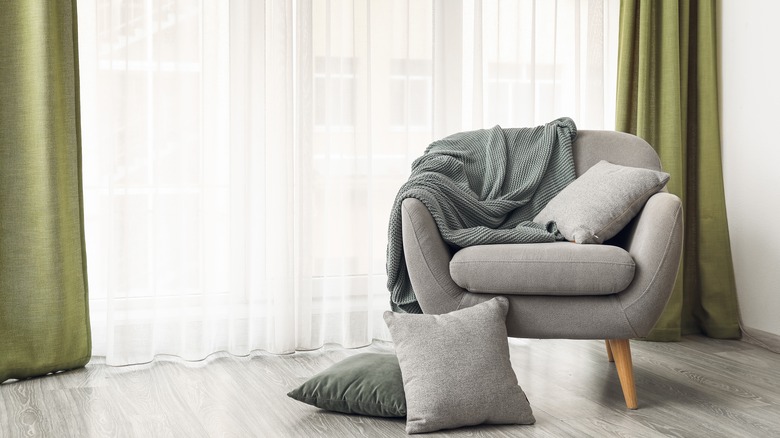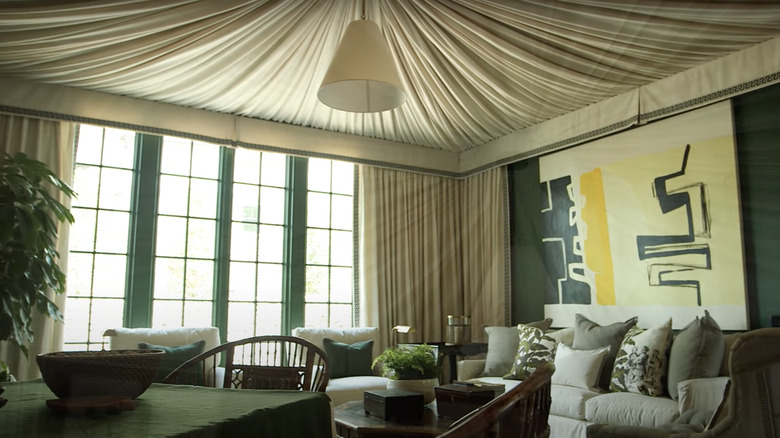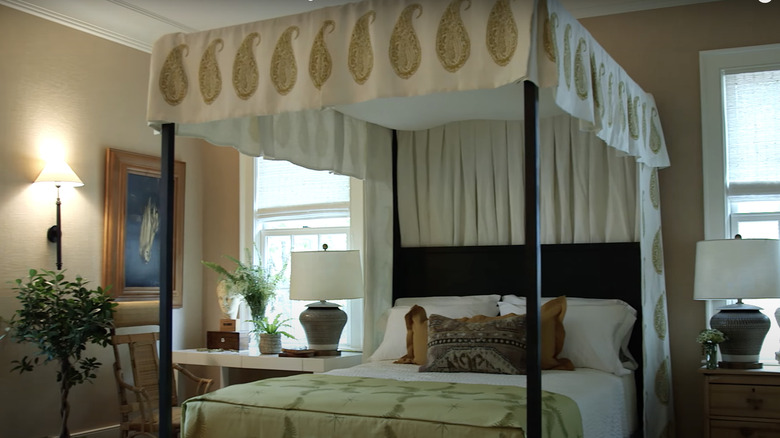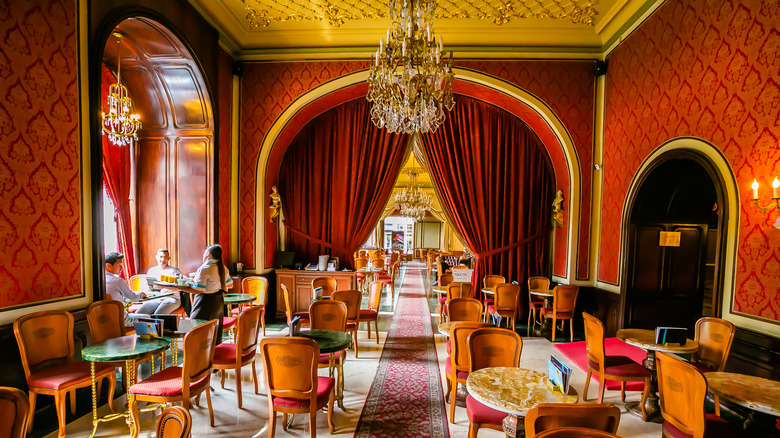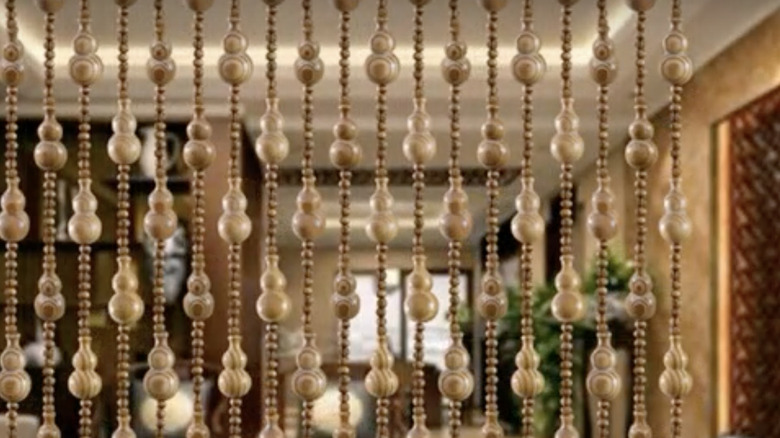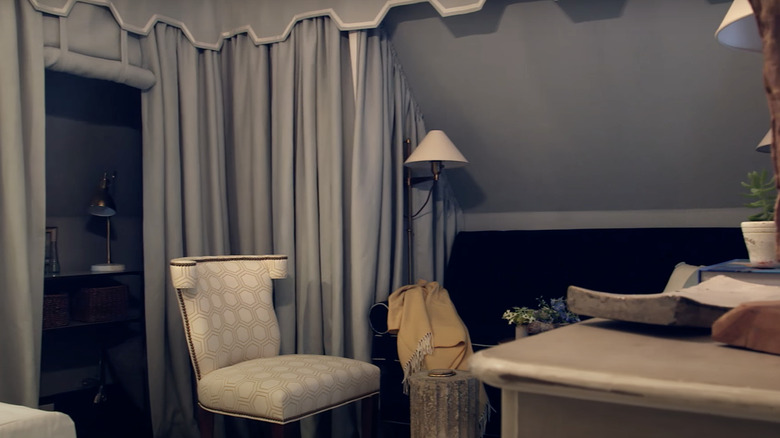5 Creative Ways To Decorate With Curtains
Curtains essentially serve one of three functions: to control the amount of light you allow into a room, to separate one designated area from another, or as decorative accents.
At their most basic, curtains are panels of fabric placed over a space, according to the experts at Nicole Draperies. And although the terms are often used interchangeably, there is a difference between curtains and drapes. Most often, drapes hang to the floor and tend to be constructed from thicker fabrics, while curtains can be anywhere from gossamer and transparent to completely opaque. It's also true that curtains are less formal, while drapes, by virtue of their weight, lean much more formal.
It's a time-honored tradition to use curtains in smaller apartments in the same way that homeowners use screens. They can easily access wardrobes, wet and winter weather gear, and pet supplies without leaving them in the open for all to see. Inevitably these bring a bohemian charm into a space that might otherwise look like a large closet instead.
Professionals disagree when it comes to what materials work best in creating curtains (via YouTube). Some maintain that natural fibers are best because manufactured synthetics sometimes appear cheap. Others suggest that synthetics and blends are fine.
With those preliminaries in mind, here are five creative ways you can elevate your space with curtains.
1. Ceiling supsension
Have you ever seen curtains suspended from a ceiling? It's a clever way to instantly bring personality to a room. These ceiling treatments call to mind the den of desert royalty and provide just enough flair to bring new life to an otherwise dull and dreary room. The professionals at Luna say that these treatments, which are most typically made of lighter fabrics like chiffon, satin, and silk, are popular additions to outdoor wedding tents, too.
In the example above, the same fabric used for the drapes has been gathered and pleated at the ceiling level and fastened both at the center and at all sides by either a cornice or a valence, which hides whatever hardware the designer has used to create the suspension effect.
The installers at Pipe and Drape take you step by step through creating this look in your home, and they suggest you start by assessing your ceiling's physical properties. What's it made from, and where are there access spots that you might be able to use for attachment? You can make great use of a ceiling that's on a grid (most often seen in office ceilings), but there are other options that include using any pipes in the room or placing tension wire.
Ceiling swag treatments are not for everyone. They can be work-intensive to install, and because they're made of fabric, eventually, the day will come when they'll require either being cleaned or replaced.
2. Bed curtains
Who hasn't looked at a treatment like this and wondered what it would be like to have breakfast, read the Sunday paper, or curl up with a good book there? It's conventional wisdom that people think of their beds as the ultimate sanctuary, a place where they can cocoon and recharge before rejoining the bustle of everyday life.
The concept of canopy beds dates back to medieval times, when even the lords and ladies slept in great halls among their servants, according to Thought Co. These coverings served multiple purposes. Not only did they keep warmth in and light out, but the hard tops (now rarely seen in contemporary design) could keep things from falling from above onto unsuspecting sleepers. However, there's disagreement among scholars about which classes made the most use of these and how.
If you're looking to achieve this effect with your bed, Mattressnut recommends first measuring the bed's posters and then selecting the right materials. Oftentimes at the head of a bed, you'll find a tester or decorative support for whatever fabric you want to drape. Lightweight fabrics are recommended, and sheer curtains provide a kind of romance novel sensuality to the effect. The length of the curtains is also an important consideration, so it's better to get more than you think you'll need rather than having the effect blunted or having to return to the fabric store.
3. Joining curtains
The example here shows how curtains used to join as well as separate rooms, and the concept could just as easily work in your home. Living rooms, dens, media rooms, and family rooms could adopt this concept to great effect.
As a historical aside, this idea was brought down to scale in the last century, when curtains came into vogue not as a way to join rooms but as a way to separate small spaces from one another. Shared apartments in urban environments often required tenants to acquire roommates, and during the Great Depression, rural homeowners would take in boarders and use curtains to separate common areas from private ones (via University of California Press). Such bohemian adaptations unfairly characterized this approach as impoverished, which, as you can see from the image above, is anything but true.
What does seem to be crucial is that you have enough space in front of and behind your curtains to have this technique make sense. While you could certainly put up a curtain to cover a closet or place a curtain over a blank wall to give the impression that there's a window behind it, this idea works best when you have a little room to stretch out.
The designers at Helen K. Lloyd have a showcase of ways to use curtains to either separate or join rooms together. They range in materials and approaches suitable for a variety of homes.
4. Beaded curtains
And speaking of history, who can look at beaded curtains and not instantly catch a whiff of patchouly in the air? Curtains made with beads have been used for millennia, and while it seems they go in and out of style, they never completely disappear.
The historians at Click Americana are quick to point out that long before hippies and fortune tellers famously put these curtains to use in the late '60s, Asian cultures have been taking advantage of them to delineate rooms and cover open areas for the last 2,000 years. Remember that one of the most important reasons to have curtains in the first place is not just to separate rooms but to filter the light coming into the room. And while the wooden beads above don't glint in the sunlight like the sparkly ones available at hobby shops everywhere today do, they still provide a sense of meditative solitude.
Online shops like Beads of Paradise can also help you take this concept to the next level with a series of designed bead curtains that display an image. There are portraits of Frida Kahlo, Gandhi, and Nefertiti, as well as a variety of animals and religious and spiritual icons. These beads can be as significant as you choose, but in terms of home decor, you want to make sure that your choice of beaded curtains fits into your personal aesthetic without reading kitschy.
5. Curtains everywhere
Nearly any place you can imagine can accommodate curtains. This room is almost upholstered in 360 degrees with variously draped curtain fabrics. Yes, you'll want to stick with muted colors or risk your space taking on a circus-like ambiance, but the idea works fairly well here.
The monochromatic choice might seem a little lackluster for some, but if you look closely, you'll see the point is almost to have curtains replace the walls of the room entirely, so that decision appears deliberate.
Ask the experts at The Great Cover-Up, and they'll explain that not only can you place curtains throughout a room — you can actually use the same fabric (or one that's complementary) as wallpaper.
Avoid anything that makes the room appear claustrophobic by choosing a lighter or more neutral fabric. For example, look at the image above and imagine what it would have been like had the designer chosen to use a beige or a lighter tone of gray. You want something that will refract a certain amount of light and not seem to be sucking it from the room.
The overweening point is that although curtains are typically considered as window treatment, there's a much wider range of ways in which they can simultaneously liven up a room and help you express your creativity. Knowing your taste, understanding what's practical given the construction of the room, and deciding whether to outsource construction will get you the results you seek.

